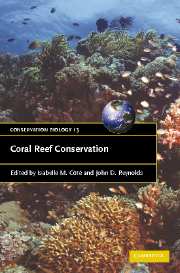Book contents
- Frontmatter
- Contents
- List of contributors
- Foreword
- Preface
- Part I Setting the stage
- Part II Uses and abuses: ecological and socio-economic issues
- Part III The way forward: tools and approache
- 9 New approaches to estimating recent ecological changes on coral reefs
- 10 Assessing the effectiveness of marine protected areas as a tool for improving coral reef management
- 11 Environmental impact assessment for coral reefs: advocating direct protective approaches
- 12 Time for a third-generation economics-based approach to coral management
- 13 Collaborative and community-based conservation of coral reefs, with reference to marine reserves in the Philippines
- 14 Education as a tool for coral reef conservation: lessons from marine protected areas
- 15 Adaptive institutions for coral reef conservation
- 16 Coral reef restoration with case studies from Florida
- 17 Redesigning coral reef conservation
- 18 Coral reef coda: what can we hope for?
- Index
- Plate section
- References
18 - Coral reef coda: what can we hope for?
Published online by Cambridge University Press: 05 June 2012
- Frontmatter
- Contents
- List of contributors
- Foreword
- Preface
- Part I Setting the stage
- Part II Uses and abuses: ecological and socio-economic issues
- Part III The way forward: tools and approache
- 9 New approaches to estimating recent ecological changes on coral reefs
- 10 Assessing the effectiveness of marine protected areas as a tool for improving coral reef management
- 11 Environmental impact assessment for coral reefs: advocating direct protective approaches
- 12 Time for a third-generation economics-based approach to coral management
- 13 Collaborative and community-based conservation of coral reefs, with reference to marine reserves in the Philippines
- 14 Education as a tool for coral reef conservation: lessons from marine protected areas
- 15 Adaptive institutions for coral reef conservation
- 16 Coral reef restoration with case studies from Florida
- 17 Redesigning coral reef conservation
- 18 Coral reef coda: what can we hope for?
- Index
- Plate section
- References
Summary
THE RECENT PAST TO THE PRESENT: THREE PHASES OF CORAL REEF RESEARCH
Before heading into the future, a brief look at where we have come from and where we are now provides some perspective. Investigations of coral reefs began in earnest with the publication of Darwin's monograph The Structure and Distribution of Coral Reefs in 1842 (see Dobbs, 2005, for a history of the resulting controversy). However, their modern study, facilitated by the use of scuba, dates back only a little over half a century. Tom Goreau's pioneering work on Jamaican coral reefs (Goreau, 1959), the French research programme in Madagascar (reviewed by Thomassin, 1971), and the establishment by Joe Connell of the first permanent reef quadrats on the flats of Heron Island (summarized in Connell et al., 1997) represent important early research efforts of this period. The first International Coral Reef Symposium (ICRS) was held in Mandapam, India, in 1969 and has been followed by nine since. The Bulletin of Marine Science started a coral reef section in 1978, and in 1982 the first issue of Coral Reefs was published.
Over this interval, the rate of production of coral reef studies has increased several fold; annual totals from BIOSIS searches of articles with the words ‘coral’ and ‘reef’ average under 75 for the 1970s, nearly 130 for the 1980s, nearly 220 for the 1990s, and over 320 since 2000, a rate of increase that exceeds that of articles retrieved with the search word ‘marine’ (Fig. 18.1).
- Type
- Chapter
- Information
- Coral Reef Conservation , pp. 538 - 549Publisher: Cambridge University PressPrint publication year: 2006
References
- 3
- Cited by

